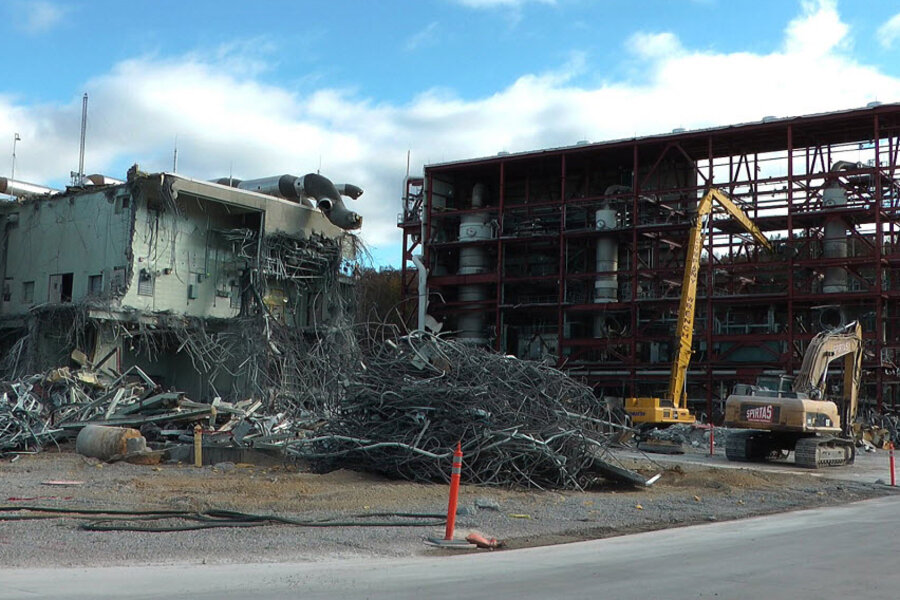Army works to destroy incinerators used to burn chemical weapons
Loading...
| Anniston, Alabama
The Defense Department spent $10.2 billion over three decades burning tons of deadly nerve gas and other chemical weapons stored in four US states — some of the agents so deadly even a few drops can kill.
Now, with all those chemicals up in smoke and communities freed of a threat, the Army is in the middle of another, $1.3 billion project: Demolishing the incinerators that destroyed the toxic materials.
In Alabama, Oregon, Utah, and Arkansas, crews are either tearing apart multibillion-dollar incinerators or working to draw the curtain on a drama that began in the Cold War, when the United States and the former Soviet Union stockpiled millions of pounds of chemical weapons.
Construction work continues at two other sites where technology other than incineration will be used to neutralize agents chemically, according to the Centers for Disease Control and Prevention.
At the incinerator complex at the Anniston Army Depot — where sarin, VX nerve gas and mustard gas were stored about 55 miles (89 kilometers) east of Birmingham — the military this week said it's about one-third of the way into a $310 million program to level a gigantic furnace that cost $2.4 billion to build and operate.
Tim Garrett, the government site project manager, said officials considered doing something else with the incinerator, but the facility was too specialized to convert for another use. Also, the law originally allowing chemical incineration required demolition once the work was done.
So teams are using large machines to knock holes in thick concrete walls and rip steel beams off the building's skeleton, which was previously decontaminated to guard against any lingering nerve agents or mustard gas. Metal pieces are being recycled, and the rest will be hauled to an ordinary landfill.
"It's the end of an era," said Garrett, a civilian.
The military said the incineration program cost $11.5 billion in all, with the cost of tearing down the four facilities built in from the start.
A $2.8 billion incinerator is being demolished in Umatilla, Oregon, the Pentagon said, and work will begin soon to tear down a $3.7 billion incinerator at Tooele, Utah. Workers already have finished demolishing the $2.2 billion Pine Bluff Chemical Demilitarization Facility in Arkansas, the military said. The site is being cleaned up and will close officially
While opponents of the incinerators predicted dire consequences and the possibility of floating clouds of nerve gas in the event of an accident, the CDC said no nearby residents were exposed to or harmed by chemical agents.
In east Alabama, before incineration work began in 2003, the military and emergency management workers spent millions of dollars distributing emergency kits to households, erecting warning sirens and reinforcing schools with ventilation systems to keep chemical weapons at bay during any accidents.
But Garrett said nothing worse than normal workplace injuries occurred by the time the last chemical weapons were burned in 2011.
"This place has the safety record of a library or a public school," he said.
More than 660,000 artillery shells, small rockets and land mines were stored in dirt-covered bunkers at the Anniston depot beginning in 1963 during the height of the Cold War. The prospect of a major accident was frightening because more than 360,000 people lived in the surrounding four counties by the time the incineration ended.
Crates of munitions were loaded into special containers and trucked from the bunkers to the incinerator, where machines dismantled the weapons and burned the chemicals.
With the incineration complete, employment at the incinerator has dropped from around 1,000 workers at the apex of the project to around 220 today, Garrett said. It will drop to a skeleton crew once all the work is done by spring; the site is supposed to be closed completely by then.
Chemical weapons are outlawed by international treaty, and their destruction is a global concern. International efforts are underway to destroy Syria's stockpile by next year. This week, Albania rejected a US request to host the destruction of Syria's arsenal.
Multiple domestic sites have destroyed chemical weapons, and the Army says it has destroyed 90 percent of the US stockpile. Plants being built in Colorado and Kentucky will destroy most of the remaining US cache with a chemical process to make it harmless. Facilities previously finished destroying weapons and were idled in Maryland, Indiana and Johnston Atoll, in the Pacific Ocean.







